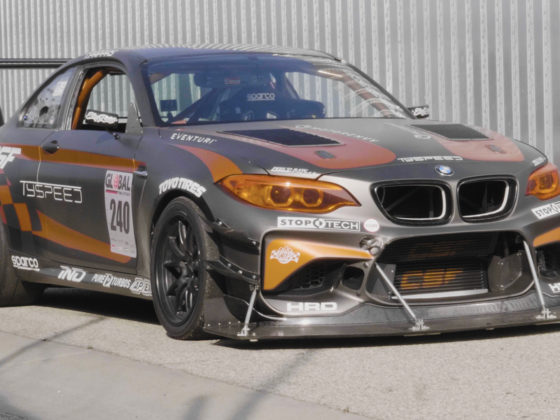
We upgraded our injectors to DeatschWerks 550cc/min parts to assure that we would have enough fuel for our newly powerful motor. The DeatschWerks injectors, part number 21U-0100450-4 are characterized and come with a flow chart showing the flow data at 450 points. This is a great help for tuning. The injectors come in flow-matched sets that are dynamically flowed and matched and a low pulse width range, a transitional range, a linear range, and wide-open static flow. This is stuff that was previously only done by a few companies on expensive injectors. Typically if injectors are sold as flow-matched sets they are only matched at wide-open static flow, not the other flow states that make up a large part of and injector’s driveability and response.

For on the engine fuel handling chores we used a K-Tuned billet fuel rail part number KRGLD. The rail has a large 0.70″ center bore and can be set up for center or side feed. The rail uses AN threads for easy conversion to AN lane and fittings. We used K-Tuned’s center mount fuel pressure gage to help make the adjustment of the fuel pressure regulator easy.
We used UltraPro black AN fittings and hose from Earls to plumb our fuel system. UltraPro Hose is glass-reinforced, carbon-infused PFTE lined to resists all fuel including alcohol with a tough polyester lightweight braid covering it.

With our plans for substantially more power out of our K motor, we had to up our fuel pump capacity from our current 255 liters per hour to our new DeatschWerks DW300 pump, part number 9-307-1009 with a 340 liter per hour flow rating. We got DeatschWerks’ application-specific configuration DW300 that will drop right into our Acura.
The DW300 has carbon commutators and a fully sealed and encapsulated armature for ethanol compatibility. TheDW300 pump has a high torque low amp motor has less stress on the OEM wiring, runs cooler and heats the fuel less.

Evey good engine needs a good header and with a highly built naturally aspirated engine with big cams, the header selection is critical for the best power production. To get the exhaust out of our engine we used with is probably the best off the shelf header for the K-Engine available, the offering from ASP or Advanced Street Performance part number RSX ST K24.
The ASP header is built from 304 stainless and tig welded. They are two-piece with a slip jointed collector retained with beehive springs for crack resistance.

Look at the clean CNC machined flange and the beautiful welds. The headers start with 17/8″ diameter primaries and are equal length.




10 comments
I don’t understand why that collector necks down before the V-band, the “reverse cone”. I don’t get how it would not induce a back pulse, granted turbulent flow physics is not my domain.
At what point in a build would you consider going to individual lambda versus the one? Would there be any gain without ITBs?
Okay well I went studying a bit on reverse cones and it seems they do generate a backpulse but in a certain RPM range that backpulse turns into a negative pressure backpulse (because of the megaphone shape) that helps suck in fresh air during valve overlap. The bad side seems to be that it has a negative impact on low RPM torque and leaves a torque dead zone during the transition into that negative pressure backpulse. That dead zone seems to be minimised by 4-2-1 headers since the second pulse mitigates the first one during that transition period… This just confirms that turbulent air is not my domain, I’ll let wizards deal with it.
In my testing, the reverse cone reduces power drop off after the peak as I said in the article.
That would make sense, the pulse sucks air in during valve overlap when your piston is near TDC where it’s not doing anything, so that pulse is virtually lengthening your intake duration.
The article I read was about reverse cone exhausts on MotoGP bikes with high RPM NA 4 where they are used to broaden the usable RPM range.
Good thing ASP only doesn’t do BP headers, I need to spend on a new winter car instead.
I don’t like complications and additional stuff on cars. Maybe for dyno headers, I might do that on a well-funded engine development program. Once you start paying for stuff out of your own pocket, you idea on how you ought to do things changes.
Curious to see how much timing you will be able to run on 91
*their magic
From previous experience with this engine, in the low 20’s.
Wow, that’s it eh? I guess with the cam timing and (maybe) small combustion chamber volume of these engines you do not need to run a significant amount of advance? I have a lot yet to learn on K tuning.
small bore too.
I have a good price on a 2012 SI, but it looks like the Z block is way less popular than the A for tuning, is it just a production quantity thing or is there some downside to the Zs that I don’t know about, I could just drop on a 20A head and keep my stock 11:1 bottom end?
Is anything specially bad on the FG that would need to be addressed for autocross? Like the EP steering/suspension geometry problems?